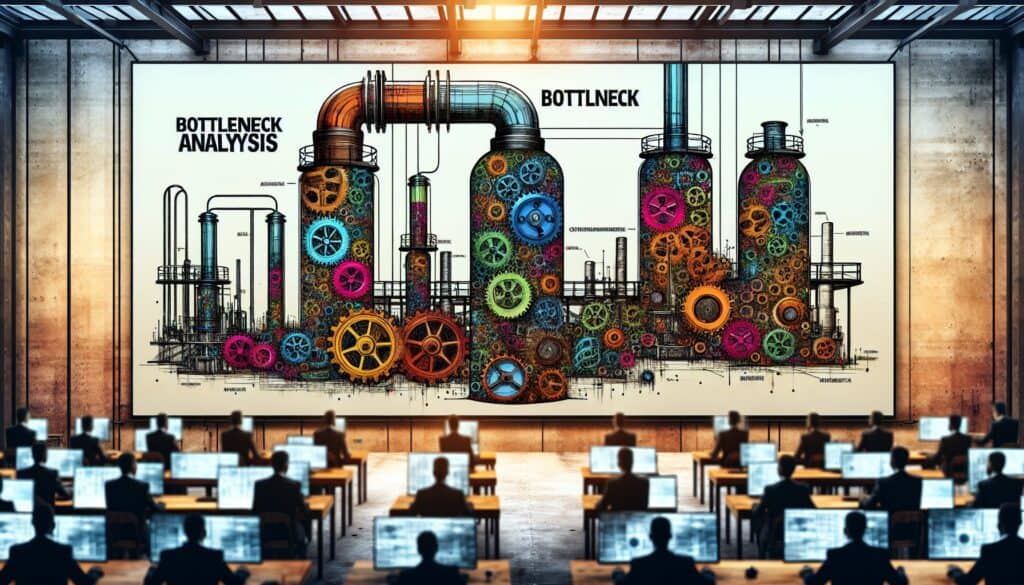To identify the part of a process that limits its overall capacity or throughput.
- Methodologies: Customers & Marketing, Ideation, Product Design
Bottleneck Analysis

Bottleneck Analysis
- Continuous Improvement, Efficiency, Lean Manufacturing, Process Improvement, Process Mapping, Process Optimization, Productivity, Root Cause Analysis
Objective:
How it’s used:
- Involves mapping out a process, identifying where work piles up or slows down, and determining the root cause of this congestion. The goal is to improve the efficiency of the bottleneck to increase overall system performance.
Pros
- Improves overall process efficiency and productivity; Helps in prioritizing improvement efforts; Can lead to reduced costs and shorter cycle times.
Cons
- Identifying the true bottleneck can sometimes be complex, especially in dynamic systems; Addressing one bottleneck may reveal another; Solutions may require investment or significant process changes.
Categories:
- Lean Sigma, Manufacturing, Problem Solving, Project Management
Best for:
- Improving process flow and increasing throughput by identifying and mitigating constraints in a system.
Bottleneck Analysis finds extensive applications across various industries such as manufacturing, software development, healthcare, and logistics, where processes can often be linear and interconnected. In a manufacturing context, this methodology aids in identifying stages within assembly lines that lead to delays, allowing for targeted interventions like machinery upgrades or reallocating labor resources to enhance productivity. In software development, bottlenecks may arise during code integration or testing phases, prompting teams to refine their workflows and improve collaborative practices by implementing tools like continuous integration/continuous deployment (CI/CD) systems. In healthcare, Bottleneck Analysis can reveal inefficiencies in patient flow, such as long wait times in emergency departments, leading to process redesigns that optimize staff allocation and patient triage systems. Initiatives typically start within teams or departments but can benefit from cross-functional participation, engaging stakeholders such as management, frontline employees, and external partners, which leads to a comprehensive understanding of the process and its constraints. Enhanced communication and collaboration among team members during the analysis phase can drive more effective solutions. Implementing Bottleneck Analysis may also involve tools like value stream mapping and cause-and-effect diagrams, enabling teams to visualize issues and prioritize actions that yield the highest benefits in efficiency and cost savings. This approach is particularly advantageous during early project phases when establishing baseline processes, making it possible to set benchmarks for future improvements and facilitate ongoing refinement as organizations adapt to changing market conditions or operational demands.
Key steps of this methodology
- Map the current process flow, detailing each step and resource involved.
- Identify areas where work accumulates or where delays occur.
- Analyze the root cause of each identified bottleneck.
- Prioritize which bottlenecks to address based on impact and feasibility.
- Develop targeted solutions for the selected bottlenecks.
- Implement the solutions and monitor their effectiveness.
- Iterate the process by reassessing and adjusting as necessary.
Pro Tips
- Utilize simulation modeling to analyze potential future states of the process under various scenarios, aiding in predicting performance impacts post-intervention.
- Incorporate continuous feedback loops from operators directly engaged with the bottleneck to facilitate real-time problem identification and innovative solutions.
- Implement multi-variate analysis techniques to explore interdependencies among different process elements, enabling deeper understanding of root causes beyond surface-level symptoms.
To read and compare several methodologies, we recommend the
> Extensive Methodologies Repository <
together with the 400+ other methodologies.
Your comments on this methodology or additional info are welcome on the comment section below ↓ , so as any engineering-related ideas or links.
Historical Context
1949
1950
1950
1960
1960
1960
1960
1940
1950
1950
1958
1960
1960
1960
1960
(if date is unknown or not relevant, e.g. "fluid mechanics", a rounded estimation of its notable emergence is provided)















Related Posts
Master Production Schedule (MPS)
Mass Customization
Marketing Funnel
Marketing Audit
MAPO Index (Movement and Assistance of Hospital Patients)
Manufacturing Resource Planning (MRP II)